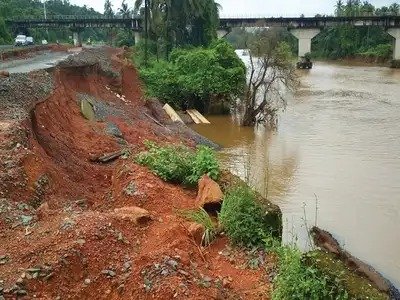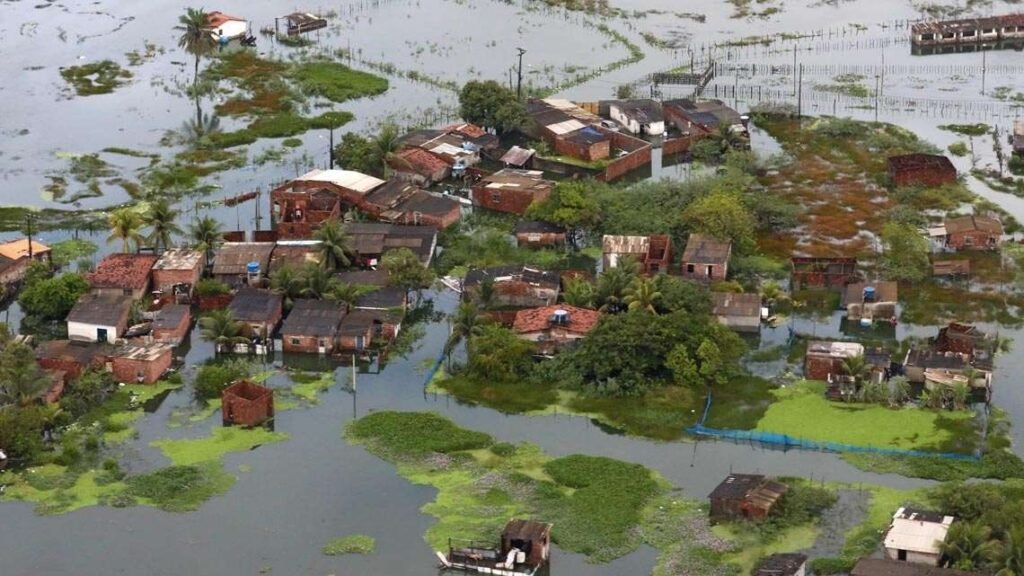A Bridge to Nowhere
With the monsoon gaining strength over Assam, Sonitpur district is in the grip of a crisis that was foretold and avoidable. A ₹3.86 crore infrastructure project under the Chief Minister’s Road Improvement Scheme was initiated in 2024. The project was to enhance connectivity between Bihaguri and villages like Jhawani and Tinikhoria through the Borchan and Manizharoni roads. The most critical piece of this plan was a bridge meant to withstand the annual flooding.

But now, that bridge is unfinished, a vacant infrastructure suspended futile in rising waters. For residents, it is no longer a symbol of progress, but a monument of deceit. It is isolated on either side, with access roads eroded, so that large tracts of land are stranded and villagers stuck in their settlements with no safe way out.
Cut Off by Water, Abandoned by Promises
The damaged bridge has made mundane tasks into perilous journeys. Villagers are trekking chest-deep waters just to get to medical centers, grab supplies, or drop off their children to school. In a moving report, a father from Tinikhoria carried his school-going son on his shoulders over inundated roads so that he would not miss an exam. The child’s school bag was held aloft while the father splashed blindly through the dirty current.
In another home, a pregnant woman on the verge of giving birth has been confined to the house for days with no access to proper medical attention, as ambulance crews refuse to visit flooded areas and no boat is supplied. With the government in absentia, locals are relying on homemade bamboo rafts, ropes, and on one another.
Farm lands Swamped, Farmers Desperate
In addition to the physical confinement, the economic blow has also been just as harsh. Hundreds of bighas of agricultural land in Sootea and other nearby areas are under water. The once fertile stretch of green, where pumpkin and other seasonal produce were grown, is now a wasteland of withered crops.
Pumpkin growers have been left especially heartbroken. Not only has the rainwater submerged their crops, but the constant wetness has also caused quick rotting of what little vegetables they managed to salvage. With no roads or transportation, those who can reap anything are being compelled to sell it at giveaway prices—scarcely ₹4 a kilo, almost half of what they received last year. Stored fruits and vegetables have also started rotting due to water and fungus, rendering them unrecoverable for most of them.
Farmers who borrowed money for seeds and fertilizers are now facing disaster. For these farmers, the floods have not only destroyed a season’s earnings—it has destroyed their potential for supporting their families.

Monsoon Misery Across Assam
The disaster in Sonitpur is a symptom of a larger humanitarian crisis in Assam. More than 6.33 lakh people in 21 districts are affected by floods. An estimated 1,500 villages are inundated, more than 14,000 hectares of crops have been ruined, and an estimated 40,000 people are living in temporary relief camps.
The Brahmaputra and its tributaries remain in excess of danger marks in most places. With rain forecast again, the threat level does not go below high. The disaster is stretching the resources thin for the state, while reports from rural interiors such as Sonitpur indicate just how ill-prepared the system was in spite of early warning.
In the past few days, the Northeast’s death toll has also increased to 44, with casualties from electrocution, floods, and landslides reported. Eight people died in the last 24 hours alone—only increasing the danger further.
A Man-Made Crisis
Though natural disasters are not always preventable, what is occurring in Sonitpur is both a product of heavy rainfall and administrative incompetence. The half-finished bridge is not merely an instance of a missed deadline—it’s an erosion of public faith. The money had been promised, the blueprints had been signed off on, but no one is held responsible for why a critical structure had been built to half completion just as monsoons were arriving.
There has been no word from the local MLA’s office or the Public Works Department on the delay. People say that work on the construction had been stalled months ago, and nothing was done despite repeated reminders. The water level going up also increased the frustration.
Urgent Appeal from the Ground
Affected families and community leaders now urge the government to take action immediately. Their call is plain but imperative: support for rescue in isolated communities, temporary bridges or boat services, health care access, and urgent relief for farmers whose industries were ruined.
Without urgent assistance, there is a very real fear that countless families will be driven further into debt and poverty. Schools are already closed, businesses have folded, and transport has ground to a halt.
The people of Sonitpur are not fighting water—they are fighting abandonment.

Conclusion: A Test for the State
As floods rage on through sections of Assam, Sonitpur is a bleak poster child for what it looks like when infrastructure vows are unkept. It’s not simply a tale of geography or weather—it’s a tale of apathy and of doing nothing, and of the repercussions. The bridge that never was may yet be constructed, but for the time being, it stands as a chilling reminder that in rural Assam, even survival is no guarantee.
The state needs to act—not with press releases or polls, but with boots on the ground, relief in hand, and a plan that gets to the people who need it most. Less than that will not just be recalled as a monsoon failure, but as a governance collapse.

